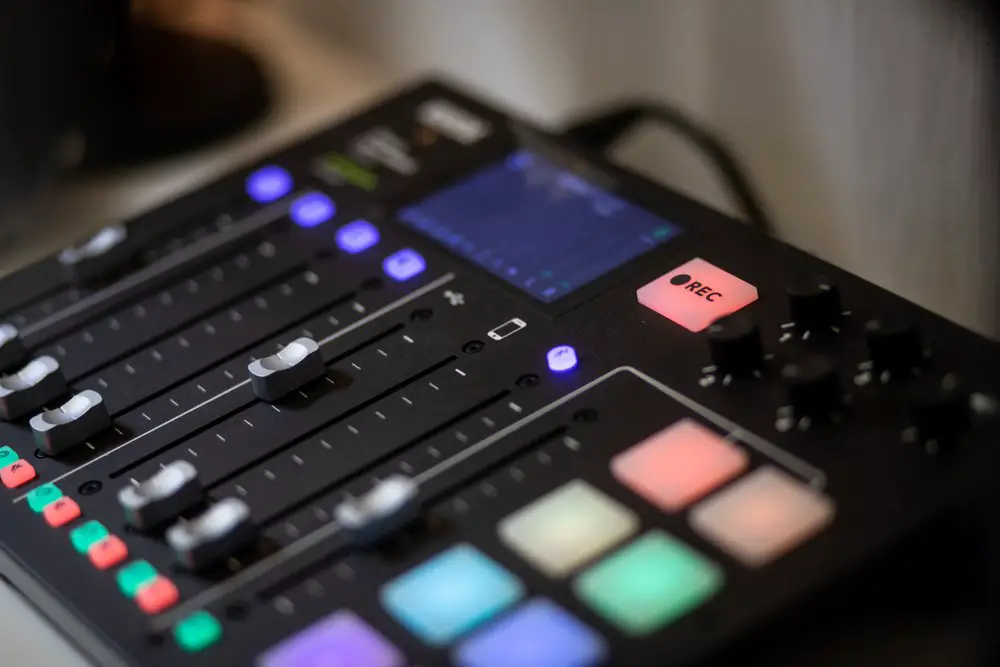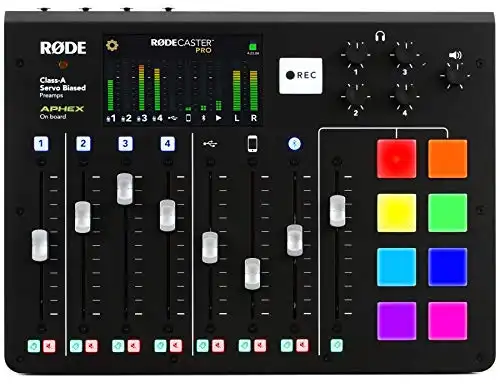There’s no doubt that podcasting is quickly becoming one of the most popular forms of entertainment.
Whether you’re looking for information, wanting to alleviate some stress with a meditation session, or fancy laughing along with a comedy show, there is a podcast for everyone.
Despite this popularity, however, one thing remains an issue for podcasters all over the world. There isn’t much audio equipment that has been engineered specifically for podcasting.
But, thanks to

Enter the
This combination of skills is essential for any serious podcaster. But what else can it do?
To give you the full breakdown of just what the
So, whether you’re new to the world of podcasting or have been hosting your own show for a while, at the end of this
See the Latest Pricing on Amazon
Table of Contents
Design
Let’s begin by talking about the
The sliders, dials and large buttons make using the Rodecaster Pro extremely simple. There aren’t any overly complicated symbols to have to decipher either, and everything is pretty self-explanatory. For instance, when you’re ready to record, you hit the large, clearly labeled record button.
Something else that we really like about the
It also gives you the ability to view them much quicker as they are angled better for your eye line.
Another fantastic design feature the
This also makes it the perfect choice for any podcaster that records remotely or travels between locations from episode to episode.
See the Latest Pricing on Amazon
Audio Recording
Whether you’re a solo-podcaster or your show’s format sees you welcome a panel of guests each week, the
First, it allows you to connect up to four microphones at once through individual XLR ports. You can even set each microphone up with its own levels using the easy-to-read control panel.
This is possible thanks to each input port having its own gain slider, mute button, and solo button. This is one of the features that make the
You want to mute everybody else’s mics while one of your guests is talking. Push the red button underneath each microphone’s slider.
There are also some other options that you can adjust each microphone individually for as well. These include:
- Compressor: This helps to level out the overall volume of each microphone
- High-Pass Filter: Minimizes low rumbling noises or popping sounds across microphones
- De-Esser: Helps to create a less sibilant recording
- Noise Gate: Reduces the amount of background noise each microphone picks up
- Ducking: Automatically lowers the volume of music being played underneath vocals
- Aural Exciter & Big Bottom: EQ preset options that change the tone of your voice
Granted, you might think these are features that can be applied during the editing process. But, by choosing to use them during your recording session, you’re taking a lot of work out of editing and freeing up more time to research some great content for your next episode.
See the Latest Pricing on Amazon
Multi-Track Recording
Along with multi-mic hosting, the
Doing this helps give you more control and flexibility in the editing process, making it even quicker and easier to give your show that professional finish.
Live Features
One way to keep your podcast format relevant and interesting is to do an occasional live show. But, most recording equipment won’t have the features you need to do this with. Again, it’s the
The first of the live-features it offers is to preview any pre-recorded files you’re planning on playing within your show. This allows you to double-check you’re about to use the correct file without interrupting the live broadcast.
This preview feature is also set to a unity gain level, so, regardless of the position you’ve got the fader in, you’ll get an accurate representation of how loud the clip is before you play it.
Another fantastic live-feature offered by the
For example, you’ll be able to brief your caller on what you’ll be talking about before they go live. You’ll also be able to check their sound levels and make sure you’ve got a strong connection with them ahead of bringing them onto the show.
Along with the individual microphone controls, these live-features also make the
See the Latest Pricing on Amazon
Sound Pads
Located on the front of the
You can even use them to play pre-recorded interviews, which, again, takes a lot of work out of the post-record editing process. These sound pads give you the ability to pause clips quickly, too, while the display panel lets you know how long is left on the clip.
This also gives you the chance to play outro music as you come to the end of each episode directly from the mixer.
Your sound library can be configured and customized from the
You’ll be able to store 8 banks of sound at once too, which is ideal if you host multiple shows or share your equipment with another podcaster.
Each of your sounds and the settings you’ve chosen for them can be saved for quick and easy access the next time you want to use them too.
This also means that you’ll be able to get ahead of the game and know that they are ready to go once you’ve hit the record button.
See the Latest Pricing on Amazon
Headphones & Monitors
While most digital recorders give you the ability to monitor sound levels through a single headphone jack, the
This means that each person can hear themselves while speaking and can customize their volume to their own preference.
So, if you’ve got one guest who prefers a louder headphone volume and one that likes things a little quieter, you’ll be able to please both people at the same time.
Each of the headphone jacks is ¼-inch TRS, which is the standard for most studio headphones. However, if you prefer to wear earbuds, adapters can easily be connected to the headphone jacks.
The
See the Latest Pricing on Amazon
Connections
As we’ve mentioned above, the
One of these is a USB connection, which can be used to record sound coming from a computer, such as an incoming Skype call.
This allows you to invite guests to your show from all over the world without having to bring them into your studio physically.
The USB connection also has its own level-control fader, solo-button, and mute button so that you can control it in the same way as the other microphone ports.
The
This allows you to record anybody calling into your show, and, as with the other connections, it also has a level-fader, solo-button, and mute button.
And, if you wanted to keep everything as wireless as possible, you can even connect to your phone using Bluetooth!
See the Latest Pricing on Amazon
Files
All of the above features are undoubtedly impressive. But how does the
The first and arguably easiest way of accessing your stored recordings is through an SD card. This keeps things wireless and helps to slimline the process of transferring files into your editing software.
You can also connect it to your computer through the USB port. This is known as ‘Podcast Transfer’ and essentially allows you to drag and drop your files into your editing software and upload them to your hosting site.
There is a clever safety feature offered up with the ‘Podcast Transfer’ method too. Anything you drag over to your computer will be in ‘Read Only’ format. This means that you won’t be able to delete them accidentally.
Accessories
The
However, if you like the idea of kitting it out as much as possible, there are a few additional accessories that can be purchased separately. These include:
- HJA-4: A pack of four 3.5mm to ¼-inch headphone adapters that allow you to connect a standard pair of headphones or earbuds
- SC9: This is a 1.5m long TRRS to TRRS cable that you can use to connect your smartphone to the
Rodecaster Pro - DC-USB1: A specialized power cable that allows you to use the
Rodecaster Pro with any device with a compatible USB output - XLR-ID: A set of colored rings that, when fixed to the
Rodecaster Pro’s XLR plugs, allow you to color-match each microphone with the interface
Price
There’s no escaping the fact the
It may be a little too expensive for anybody that is just starting on their podcasting journey, though. If you know what you need your show to sound like, and you are certain that you’ll use all of the features, however, it’s a bit of kit that will change your entire recording experience.
Final Word
The Rodecaster Pro stands out from the crowd for its uniqueness, simplicity, versatility, and portability. Each of its remarkable features is ideal for recording various podcast formats and are engineered towards giving your show the best quality sound possible along with that professional finish.
It is an expensive piece of equipment, though. However, it’s one that contains a lot of features that you’d ordinarily need to purchase several different adaptors and devices to achieve.
This means that, although your wallet will feel the blow initially, you could actually end up saving yourself a lot of money as your show evolves.
Think of the
So, if you’re serious about podcasting, there’s absolutely no doubt that the
